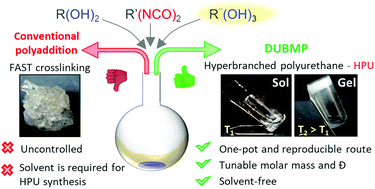A one-pot, solvent-free, and controlled synthetic route for thermoresponsive hyperbranched polyurethanes†
Abstract
Hyperbranched polyurethanes (HPUs) are known for their multifunctionality and versatile properties. Despite the importance of this class of polymers, the issues associated with their synthesis remain a challenge, such as the lack of reproducibility, the need for polymerization in diluted solutions to avoid crosslinking, and the need for purification with organic solvents. Here, we report the synthesis of HPUs based on poly(ethylene glycol), polycaprolactone triol, and isophorone diisocyanate by dynamic urea bond-mediated polymerization (DUBMP). This polymerization technique allowed for kinetic control over the molar mass distribution and suppressed the formation of by-products. Besides, gelation was not verified up to 0.91 conversion. Both molar mass and dispersity of the HPUs were precisely tailored by hindered secondary amine/isocyanate molar ratio, time, and temperature of the polymerization. HPUs with molar masses ranging from 4 kDa to 49 kDa, molar mass dispersities ranging from 1.6 to 2.8, and properties varying from viscous liquids to elastomers were obtained by changing the synthetic parameters. Furthermore, amphiphilicity imparted an LCST phase behavior to HPU aqueous solutions, which depends on both their molar mass and composition. Thermoreversible gels were formed at around 30 °C, driven by the macroscopic phase separation of HPU aqueous solutions. Finally, HPUs showed high cell viability against mouse fibroblasts.



 Please wait while we load your content...
Please wait while we load your content...